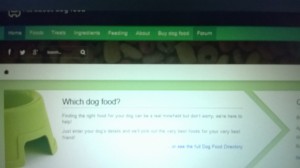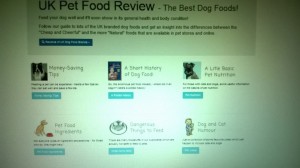HEALTHY DIETS FOR DOGS
You could give yourself a break from your own New Year’s healthy living resolutions and concentrate on your dog’s health instead!
You will do your dog a huge favour, and very likely reduce your vet’s bills, if you offer your dog a healthier (and more palatable) food choice.
Please note that if your dog has a medical condition which requires a specific diet then you will need to speak with your vet if you are considering changing to a new diet.
Also please note that any change of diet should be done by gradually incorporating the new food into your dog’s current diet, a little at a time.
POSSIBLE SIGNS YOUR DOG MIGHT BENEFIT FROM A CHANGE IN HIS FOOD
- Does not eat his food with gusto?
- Or perhaps he does happily eat up his multi-coloured, additive-rich, unnaturally flavoured food? You know, the ones which are designed to appear natural because they have green and orange colours in them, reminiscent of of lots of lovely vegetables but these are in fact quite the opposite – unhealthy additives which the clever marketing departments have come up with.
- Has skin problems (scratching and nibbling at skin and paws but does not have fleas or other parasites)?
- Has recurrent ear problems (which are not due to mites or other obvious causes)?
- Has soft poos (which do not help to empty a dog’s anal sacs naturally and can cause problems)?
- Does a lot of poos each day (the more low quality and undigestible ingredients in your dog food will mean more toileting to expel the waste products).
Dog food manufacturers are very good at concealing what they put in your dog’s food. Even food which claims to have no artificial additives added may in fact have them. That is because legally manufacturers do not have to state that a feed has additives if they were added to the ingredients prior to the manufacturers’ purchase of them – bizarre, totally unethical, but true.
To make life easy for you to understand ingredients and to check what is in your dog’s brand (and the specific food within that brand) there are a couple of good sites I have found (and I think it’s worth checking more than one site to minimise the risk of any bias towards manufacturers):
WEBSITES TO HELP YOU RESEARCH YOUR DOG’S FOOD
If you only have time to look at one site, I would suggest this one.
Firstly, read the ‘Dog Food Ingredient Glossary’ – all the basics you need to know about what to look for plus lots of extra information, such as: did you know that green tripe is tripe that has not been cleaned, bleached or otherwise processed. Green tripe is unique because it contains high levels of probiotics including friendly bacteria and digestive enzymes that can enormously benefit a dog’s digestion. It smells disgusting, of course, but dogs love it!
You can then:
- Search the site by dog food brand and sub-brands;
- Choose by dry, wet or raw food;
- View each food’s contents in detail;
- See a breakdown of nutritional values for each food;
- Opt to view only foods with a high quality ranking;
- Read reviews by other dog owners;
- Compare products;
- Search by puppy, adult, or weight of dog;
- Find the daily cost for each dog food by selecting the weight of your dog on a quick to use slider. Please see note below re this.*
- Narrow your required results by using a number of easy-to-use filters. For example, search by breed, grain free, natural, high protein, etc.
- See the reviews section about how each food rates in protein, fat, fibre, ash, carbohydrates. You do not have to be a nutritionist genius to understand this as there are clear diagrams showing you if the food is below average, average, or above average.
Please note that the image of food comparisons above is an example but does not mean these are the foods I would recommend. You need to research the right type of food for your dog.
*As mentioned above, you can check by budget but please remember that if you feed your dog the cheapest, low quality food which contains cheap ‘filler’ contents then you may well pay more in the long run in the form of vets’ bills for digestive, skin problems and ear infections, etc, etc.
Also do you not think your dog should look forward to his meals as much as we should?
I have several clients who have seen a huge improvement in their dogs’ health since changing from a cheaper food to a more natural, better quality food. Personally I have always fed my own dogs a varied diet which they have been keen to eat and have had no food intolerances or health problems caused by such a diet.
FOODS TO AVOID FEEDING YOUR DOG
Please ensure if you are feeding human food that you read the British Veterinary Association’s Pet Poison’s leaflet (http://www.bva-awf.org.uk/pet-care-advice/pets-and-poisons ) to ensure you are aware of food which your dog must not be given – this includes the food itself and also the contents of processed food (such as xylitol which is extremely toxic to dogs) – see ( http://www.vcahospitals.com/main/pet-health-information/article/animal-health/xylitol-toxicity-in-dogs/4340
FEEDING A RAW DIET
If you are interested in feeding your dog a raw diet then there is information on www.allaboutdogfood.co.uk as well as a number of raw food providers from where you can purchase either the separate ingredients (meat, bones, natural chews, etc) or buy their own freshly prepared meals of meat and vegetables. I have found Honey’s dog food very helpful and knowledgeable and they are happy to speak over the phone to advise you if you are interested in finding out more about feeding a raw diet. ( www.honeysrealdogfood.com )
If you are interested in reading more about the food you feed your dog, the following site is also good ) www.pet-food-choice.co.uk.
© 2016 Sally Bartlett
Co-operative Canines Dog Training & Behaviour



